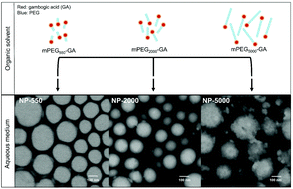Utilization of click chemistry to study the effect of poly(ethylene)glycol molecular weight on the self-assembly of PEGylated gambogic acid nanoparticles for the treatment of rheumatoid arthritis†
Abstract
Many small-molecule drugs exhibit poor aqueous solubility, and various approaches have been developed to improve their solubility and delivery. Chemical conjugation of an insoluble drug to a hydrophilic polymer can promote the self-assembly into nanoparticles (NPs) to increase the apparent solubility and improve the pharmacokinetics of the drug. However, majority of the reports in the field disclose only one composition of the conjugate, while accumulating evidence suggests that structure–activity relationship (SAR) studies must be conducted to identify an optimal construct. In this study, we employed a click chemistry platform to robustly conjugate short-chain methoxypolyethylene glycol (mPEG) of three different molecular weights to a small molecule anti-inflammatory drug, gambogic acid (GA), and studied the SAR. NPs formed with mPEG550 and mPEG5000, referred to as NP-550 and NP-5000, respectively, had larger mean diameters (130.0 ± 16.9 nm and 143.0 ± 0.1 nm, respectively) and higher critical micellar concentrations (CMCs, 9.5 μg mL−1 and 10.5 μg mL−1, respectively) compared to NPs formed with mPEG2000 (NP-2000, mean diameter = 97.8 ± 5.0 nm and CMC = 6.6 μg mL−1). NP-2000 and NP-5000 did not cause significant hemolytic toxicity, whereas NP-550 and free GA induced 90% and 60% hemolysis, respectively. NP-2000 was selected for further studies due to its improved safety, small size and low CMC. In cultured inflammatory macrophages, NP-2000 exhibited activity comparable to free GA in suppressing tumor necrosis factor-α. In mice, NP-2000 showed 185-fold improved drug exposure compared to free GA after intraperitoneal delivery. Treatment with free GA showed little anti-inflammatory activity compared to vehicle control in a murine model of rheumatoid arthritis. In contrast, NP-2000 significantly reduced the paw inflammation by 27% from day 15 to day 29. NP-2000 showed no visible signs of toxicity in mice, while free GA elicited significant irritation at the injection site. Our work emphasizes the importance of performing SAR studies for developing an optimal drug–polymer conjugate for self-assembly into NPs. We also demonstrate a unique application of click chemistry to robustly synthesize a small library of conjugates for the SAR study.



 Please wait while we load your content...
Please wait while we load your content...